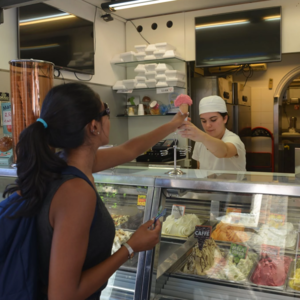Two college students. One pie. Going in I thought, “How hard could this possibly be? I write about food all the time!” Key word: write. According to the dictionary, the term “foodie” refers to a person with a strong interest in—you guessed it—food. However, this doesn’t necessarily translate to competence in the kitchen—while my ability to eat food is first rate, my abilities to cook/bake/make food are not so great.
After coming across this “Quick and Easy” recipe I figured I would give it a shot, and even add a meringue topping because why not? After all, according to the instructions the pie would only take about 30 minutes. That estimation was approximately correct…give or take 2 hours. Below you’ll find an account of some key moments you can expect when letting novices in the kitchen.
Minute 0: Getting started
Me: “Mom where is [lists every ingredient and piece of equipment necessary]?” I should have known it was going to be a bumpy journey from the beginning.
Yes, I was home for break and should know where things are in my own kitchen, but I am away at school most of the time so I have an excuse. Maybe the pantry was rearranged. Or maybe we were out of every ingredient on the list.
Minute 10: Getting started part 2
Me: “Mom we only have 9/10 of a stick of butter but I need a whole stick what do I do?!” After a brief consideration of abandoning ship and buying a pie from the grocery store, I took a deep breath. I thought about all the work I had already put in: driving to the store to get saltines, buying saltines and driving home. It was clearly too late to back out. I had to persevere with an incomplete stick of butter.
SpoonTip: Canola oil can be used to substitute small amounts of butter when you’re in a bind.
Minute 20: Making the dough
After expertly smashing the saltine crackers with a mortar and pestle, it was time to make the crust. The directions read “add butter to make crumbs into a dough-like consistency. Press the crumbles into the pie pan to form the crust.” As I mushed together the softened butter and cracker crumbs, I kept waiting for it to turn “dough-like.”
That moment never came.
As someone who has experienced the consequences of not following a recipe properly, I feared it was because of the missing 1/10 stick of butter. I was assured this wasn’t the problem, so I ignored the discrepancy and pressed the cracker mixture into the pan, hoping for the best.
Minute 30: Baking the dough
While preoccupied with the butter situation, I had forgotten to preheat the oven. A few frustrated shouts at the Baking Powers That Be and twenty minutes later, the non-dough-like saltine crust was popped in the oven to golden.
After eighteen minutes of nervousness that the crust would burn or fall apart, I pulled it out of the oven to find an intact, golden crust. Cue sigh of relief.
Minute 70: The filling
The filling-making process was surprisingly obstacle free. I was ready to add the filling to the crust, only to find that the pie pan and crust were still much too hot to work with. Improviser that I am, I wrapped the pan and shoved it in the freezer on top of whatever else was in there, praying it wouldn’t slip off and fall to the floor when someone opened the door.
Minute 90: Baking the pie
Finally, the crust was cool, the oven was hot and the filling was ready to be poured. The experiment was starting to take the shape of real edible food. While the pie baked, I figured it was high time to start the meringue.
Even though the recipe says whipped cream works as well, I had already committed to the meringue and spent 1.5 hours on this pie. The final product had to be perfect.
Minute 95: Meringue
I had heard how difficult meringue could be, so I wasn’t sure how this would play out. Adding the cream of tartar and egg whites into a mixer, I waited for those signature soft peaks to form. It’s worth noting that the meringue recipe called for four egg whites and the filling recipe called for four egg yolks. I used eight eggs total rather than reading first and only using four.
Key lesson: read the recipe ahead of time.
After the allotted amount of time there were, of course, no soft peaks to be found. Pretending everything was okay, I kept at it until finally, ten minutes later they made an appearance.
Minute 120: Putting it together
Spreading the meringue over the top of the pie, I quickly realized that the beautiful, even points seen on pies in the bakery were not going to be a reality for me. The recipe said to use a spoon to create the curls, but all it did was make dents in the topping.
After trying to create some aesthetically pleasing dents, I decided it was time for the last round of baking to cook the meringue and create that picture-perfect toasted brown top.
Minute 140: The finished product
The pie was complete in all its glory. I had never seen a more beautiful pie – likely because the blood, sweat, and tears I put in were clouding my vision. After another two hours of cooling I got to indulge in my work, and it made the entire process almost worth it.

Final tip: If this article scared you away from baking, you can get a pretty amazing Atlantic Beach Pie from Hoosier Mama or even Wegman’s. It might not have the secret ingredient (read: your soul), but it comes pretty close.


